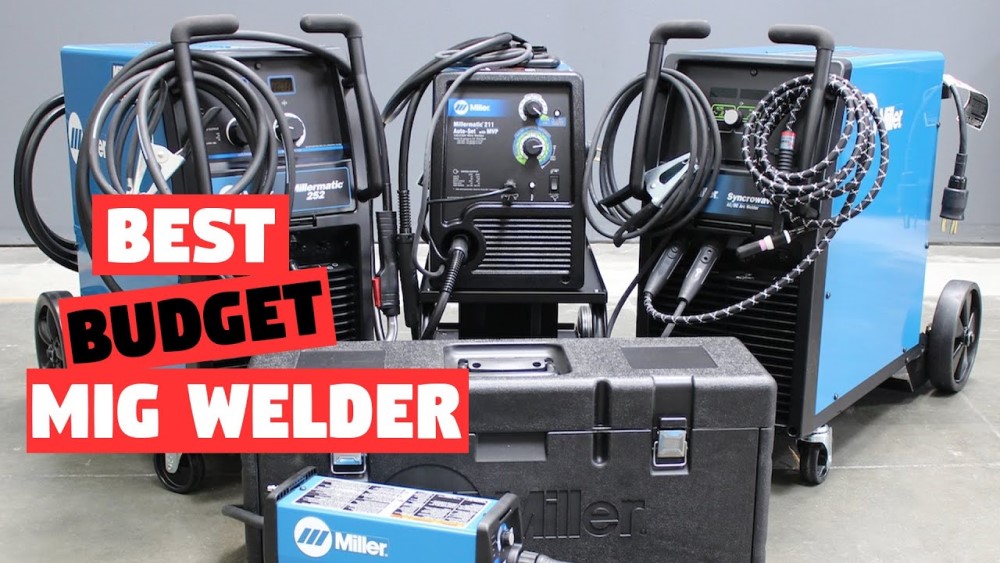As you know, aluminum welding is currently a promising welding method and is widely applied in the mechanical and machine-building industries. Whether you are a seasoned welder or just starting out, you need to know about aluminum welding and what is involved in it. Also, if you came here to find the best MIG welder for aluminum then WeldFAQ is also available in this blog!
What is aluminum welding?
Aluminum welding is the process of joining two pieces of aluminum together by heating them to the melting point and using a filler material to join the pieces. The filler material is typically in the form of a wire, which is fed into the welding arc, melted, and combined with aluminum to form a solid joint.
Aluminum welding can be performed using various welding techniques, including MIG (Metal Inert Gas) welding, TIG (Tungsten Inert Gas) welding, and stick welding. Each of these techniques has its own advantages and disadvantages, and the choice of technique will depend on the specific application, the thickness and type of aluminum being welded, and the desired appearance of the finished weld.
Notes when welding aluminum
Cleaning the aluminum’s surface
In addition to using the appropriate aluminum welding process, the metal surface needs to be well-cleaned prior to welding in order to create a more robust weld. To prevent the metal filling from penetrating too deeply into the solder, the aluminum oxide part of the surface in particular needs to be removed.
It is important to use a slag hammer or a corrosive solvent to remove the surface aluminum oxide layer and contaminants. In order to reduce the chance of acquiring oxide on the surface of the solder, you should pound the slag with a hammer softly and uniformly. If you have a sander in your workshop, utilize it for this. The solvent must ensure that the detergent is free of hydrocarbons.
Choosing a shielding gas for aluminum welding
Shielding gas with Agron, which is frequently used in Tig welding, provides a cleaning effect and improves weldability and penetration. Argon and helium gases can be used to reduce the production of magnesium oxide. So, Argon gas can be used to weld metal. However, it is preferable to use a combination of shielding gases.
Setting the arc length for aluminum welding
The distance between the welding pliers and the workpiece is another name for the arc length. When welding aluminum, keep the welding pliers away from the workpiece while still keeping them close enough to prevent a fall in heat concentration from resulting in a reduction in the depth of penetration.
1.5 times the electrode diameter is the ideal arc length. Due to the lengthy learning curve and extensive Tig welding experience, the majority of skilled aluminum welders are extremely precise emotional welders.
Use a pulse welding process for thicker aluminum
Pulse welding is often used for welding thicker aluminum because it provides better control over the heat input and helps reduce the risk of warping, cracking, and other defects. With pulse welding, the current is pulsed on and off, rather than flowing continuously, which helps to distribute the heat more evenly and prevent overheating in certain areas. This can result in a stronger, more uniform weld with fewer defects.
Weld in a controlled environment to minimize contamination
Welding in a controlled environment, such as a clean and well-ventilated room, can help minimize contamination from dust, moisture, and other particles that can weaken the weld or cause defects. Keeping the work area clean can also help prevent accidental contact with the molten metal, which can cause contamination and negatively impact the quality of the weld.
A Quick Comparison for best MIG welders for Aluminum
Some popular MIG welders for aluminum under $1000 include:
- Lincoln Electric Easy MIG 140 is a good choice for those who are looking for an affordable and easy-to-use MIG welder for welding steel and aluminum.
- Hobart Handler 500553 210 MVP is a multi-voltage plug (MVP) MIG welder that is designed for welding steel, aluminum, and stainless steel.
- Eastwood 180 Amp is a high-performance MIG welder that is designed for welding steel, aluminum, and stainless steel.
- Forney Easy Weld 261, 140 FC-I is a compact and affordable MIG welder that is designed for welding steel, aluminum, and stainless steel.
- LOTOS MIG175 is a versatile MIG welder that is suitable for welding steel, aluminum, and stainless steel.
These welders are highly rated and offer a good balance of performance, versatility, and affordability for welding aluminum.
Here are two highly rated MIG welders for aluminum under $500:
- YesWelder MIG-205DS is a compact and affordable MIG welder that is designed for welding steel, aluminum, and stainless steel.
- Forney Easy Weld 271, 140 MP is equipped with a multi-process capability, allowing the user to switch between MIG, Stick, and TIG welding, making it a versatile choice for a variety of welding applications (for welding steel, aluminum, and stainless steel).
- Lincoln Electric K2185-1 Handy is a compact and portable MIG welder that is designed for welding steel and aluminum.
- Eastwood 140 Amp is a compact and affordable MIG welder that is designed for welding steel, aluminum, and stainless steel.
- Hobart 500572 Handler 100 is a compact and portable MIG welder that is designed for welding steel and aluminum.
These MIG welders are affordable and offer the basic features and performance required for welding aluminum. They are a good choice for DIY projects, hobbyists, and light-duty welding applications.
Best MIG welder for under 1000
1. Lincoln Electric Easy MIG 140
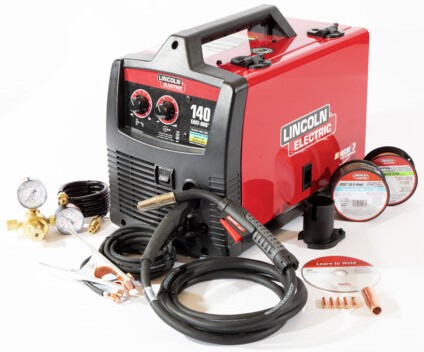
This type is the lightest and may be used for welding on the go if you’re seeking for a transformer MIG welder. It is a suitable option for hobbyists for light soldering because of its low duty cycle and output amperage.
Since the Lincoln Electric Easy MIG 140 only needs a standard 120 volt input power supply, it may be used practically everywhere. It is simple to set up for gas protected MIG welding on thin steel, stainless steel, or aluminum with a two-knob control or gasless flux core welding for deep welding on thicker steel.
One of the top manufacturers of welding equipment is Lincoln Electric, and its products are long-lasting. If you don’t want any more functions, the Easy MIG 140 is a cheap option because it has a very decent build quality for the cost.
The Lincoln Electric Easy MIG 140 is a budget-friendly, entry-level MIG welder that is suitable for light-duty welding tasks such as automotive repair, household repairs, and hobby welding projects. It is a compact and portable machine that offers a user-friendly interface and easy setup.
The welder can handle mild steel, stainless steel, and aluminum welding wire with a thickness range of 24 gauge to 3/16 inches. The machine operates on standard 115V household power and has a maximum output of 140 amps. Additionally, the Easy MIG 140 is backed by a 3-year warranty, providing peace of mind for the user.
2. Hobart Handler 500553 210 MVP
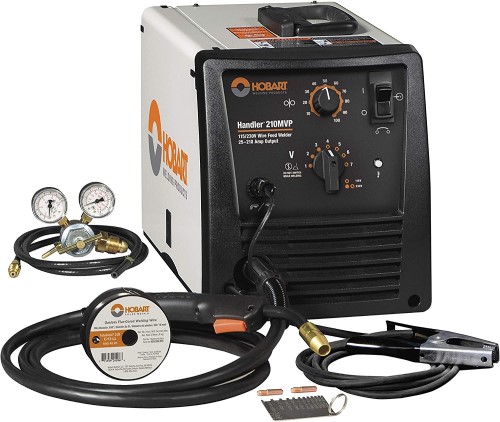
The 210 MVP MIG welder contains nearly all the features you’d anticipate from a MIG welder despite its low cost. It is made to make it simple for you to produce welds that are tidy and of excellent quality.
The Hobart Handler 500553 210 MVP is a multi-voltage plug (MVP) MIG welder that can operate on both 120V and 240V input power. This makes it suitable for use in both home and industrial settings. The welder is capable of welding mild steel, stainless steel, and aluminum with a thickness of up to 3/8 inch.
It has a duty cycle of 20% at 150 amps, which allows for continuous welding without overheating. The Hobart Handler 210 MVP is also equipped with a 7-position voltage control selector that enables the user to fine-tune the arc for optimal results. Additionally, the welder is backed by a 5-year warranty, providing peace of mind for the user.
It has 7 voltage position options, enabling you to produce clean, accurate welds. This MIG welder has 210A of power, which is more than enough to easily handle all of your welding needs. Additionally, it offers 115V and 230V dual voltage options, providing you the versatility you need to produce neat, high-quality welds.
With its fine control features, you can simply adjust the output parameter to enhance arc performance, reduce spatter for better particle shape, and require less cleanup. Additionally, this device keeps the cord cool until the trigger is pulled, protecting you.
3. Eastwood 180 Amp ($589.99)
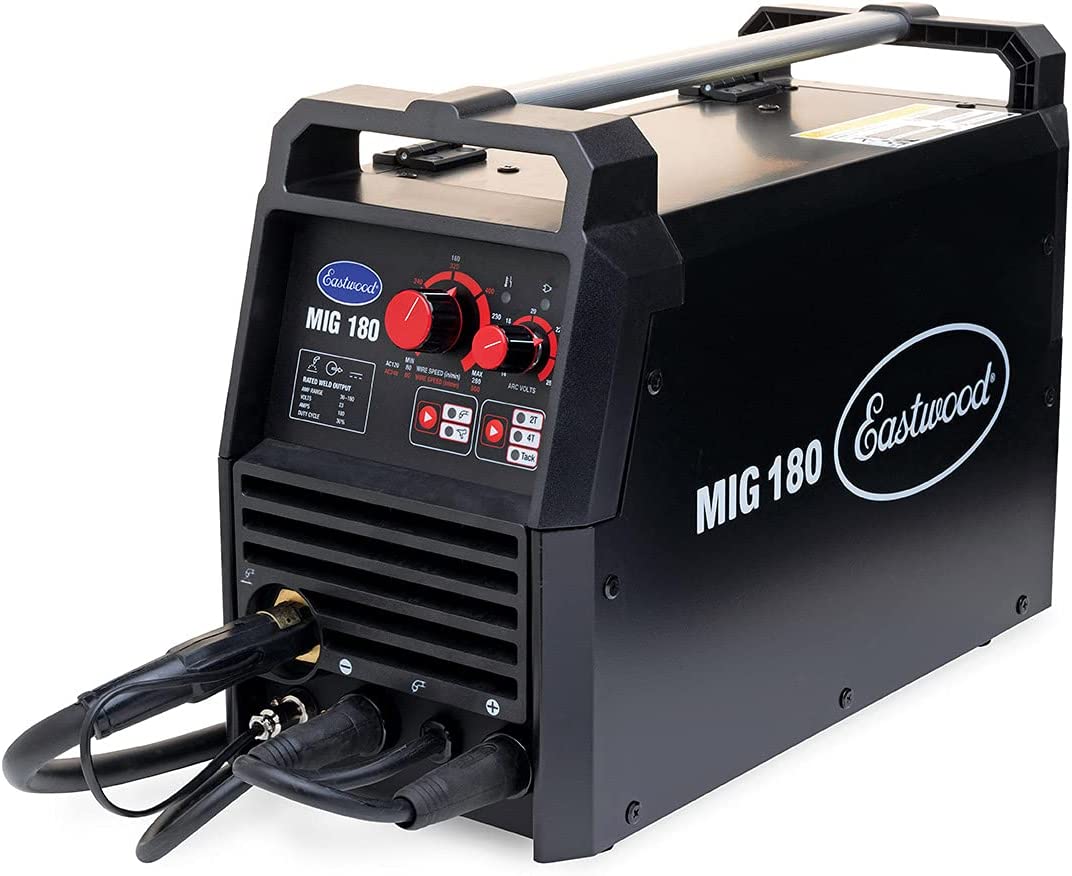
Due to its inexpensive price and outstanding arc quality, this welder is a fantastic option for beginners. Additionally, its simplicity of use and added features are highly helpful for beginners.
For best utility, the Eastwood 180 Amp runs on both 120 and 240 volts. Aluminum, stainless steel, and mild steel can all be welded to a thickness of 1/4 inch. welding with a spool gun on aluminum, 14 gauge to 1/4″, and mild and stainless steel, 24 gauge to 5/16″ (3/16″ on 120V).
It is portable and light since it makes use of the most recent IGBT inverter technology. You may weld using other features like the 2T/4T mode without constantly depressing the torch trigger (4T). Additionally, the tack capability makes it a terrific option for sheet metalworking because it enables you to make uniform butt welds.
For use at home and in DIY projects, the Eastwood 180 Amp MIG Welder is a lightweight, portable MIG welder. Additionally, it has a consistent arc that is smooth and produces high-quality welding results. Users can feel secure knowing that the Eastwood 180 Amp MIG Welder is covered by a 3-year warranty.
4. Forney Easy Weld 261, 140 FC-I

This welding machine is dependable, reasonably priced, and incredibly simple to use. With this machine’s 0.30 flux core wire and limitless voltage and wire feed speed controls, you may modify your soldering parameters for the ideal weld. Aluminum, stainless steel, and mild steel can all be welded to a thickness of 1/4 inch.
It includes two 120/240 volt inputs, giving you a wide range of connection possibilities. This amazing MIG welder has a die-cast aluminum wire drive system that can accommodate 4-inch and 8-inch coils, and it operates at 90 amps with a 30 percent duty cycle.
Because it doesn’t need gas and can run on regular home electricity as long as you have at least a 20 AMP breaker, the Forney Easy Weld 140 FC-i is quite practical. An infinite voltage controller is another feature of the Forney Easy Weld 261, 140 FC-I that enables the operator to fine-tune the arc for the best results.
Powerful flux cored welders like the Forney Easy Weld 140 FC-i are available. The DIY, maintenance, repair, metal fabrication, and hobbyist markets are perfect for this machine. With its incredibly low weight and small size, the Forney Easy Weld 261, 140 FC-I MIG is simple to transport to work without the use of a wheeled cart.
5. LOTOS MIG175 ($610.54)
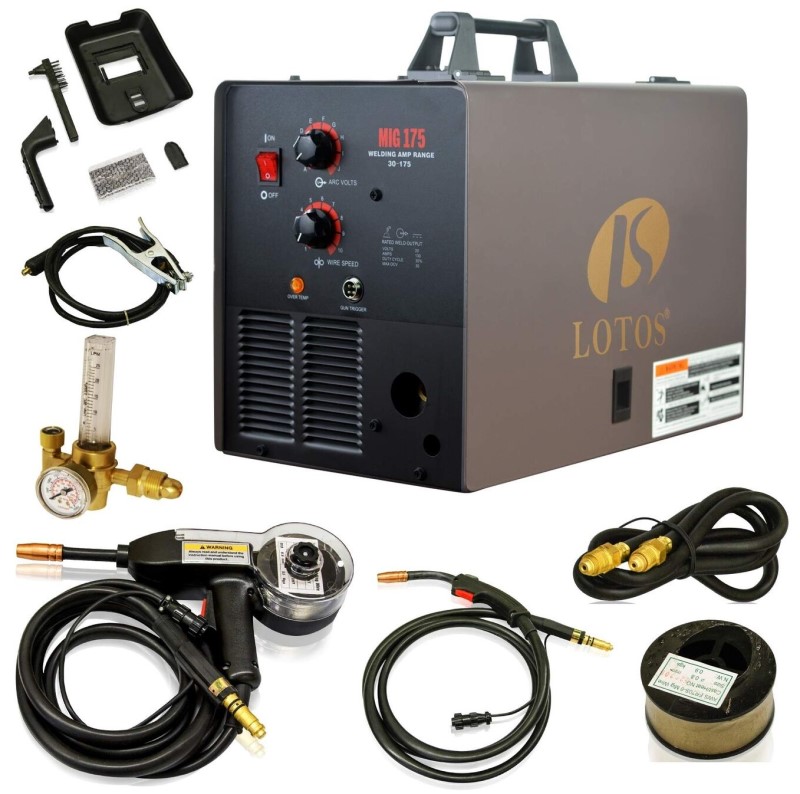
A solid welding experience is provided by the supplied aluminum wire feeder. Additionally, this machine has a high-speed MIG gun that can feed challenging wire through a standard MIG sensor. The 85 lb. LOTOS MIG175AMP MIG welder is a hefty piece of equipment. To make moving it about the office easier, you must get a wheeled trolley.
30% duty cycle at 135 amps and 20% duty cycle at 175 amps are both available on the LOTOS MIG175AMP MIG welder. For tidy and accurate welds, this MIG welder also has wire speed regulation and infinite solder speed. This machine can weld steel and aluminum up to a thickness of 1/4 inch. Additionally, 6-inch and 4-inch coils can be handled.
The welder features a user-friendly interface, making it easy to set up and use, even for beginners. It also has a smooth and stable arc, which results in high-quality welding results. The Lotos MIG175 MIG Welder is equipped with a built-in spool gun for easy welding of aluminum and a flux-cored wire capability for welding without shielding gas.
This machine creates precise, clean cuts on a variety of surfaces and materials, including brass, stainless steel, aluminum, and other conductive materials. It is consequently perfect for both professional use and do-it-yourself household projects. A one-year guarantee is also included with the welder, giving the user further assurance.
Best MIG welder under 500
1. YesWelder MIG-205DS ($469.99)
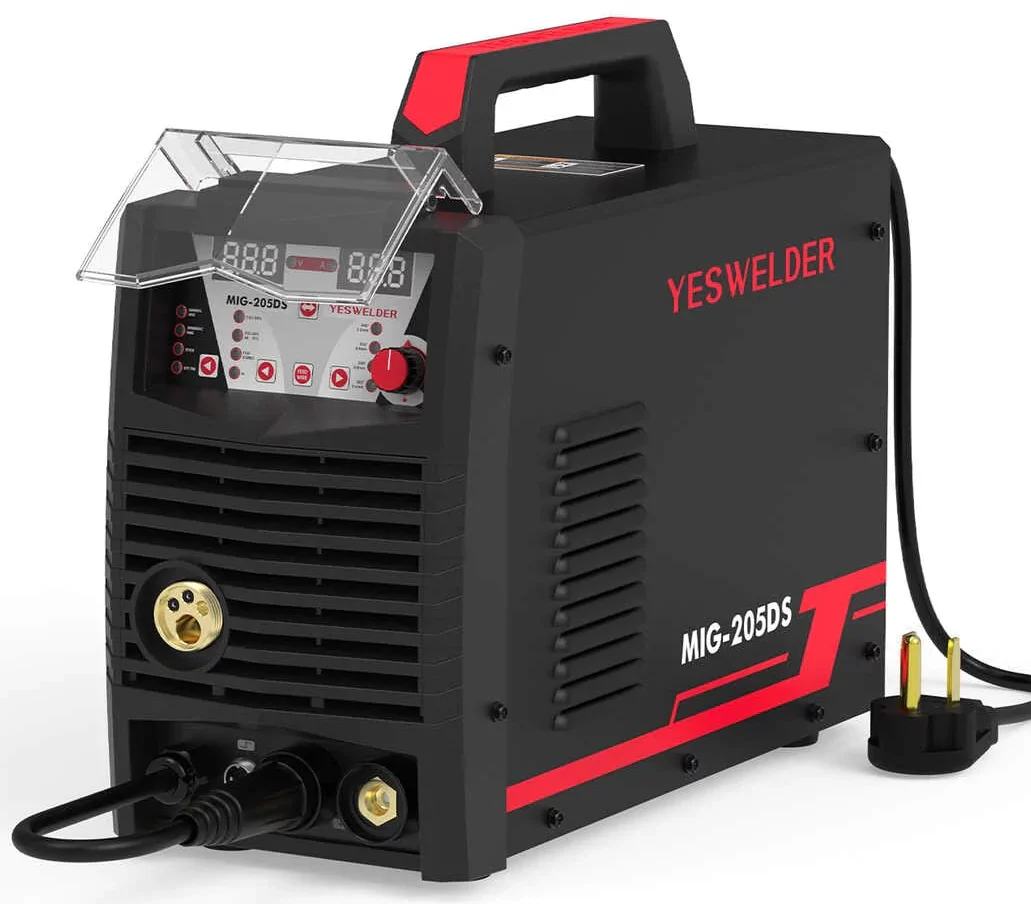
Despite being a cheap device, it performs better than expected. It’s a fantastic option for hobbyists because of this, especially if you want to perform some stick and TIG welding.
The YesWelder MIG-205DS is a portable MIG welder designed for welding mild steel, aluminum, and stainless steel. It features dual voltage input (110V/220V), a digital display that shows the welding parameters, and an adjustable wire feed speed and voltage. The machine comes with a Euro connect torch, ground clamp, and a face mask.
It can weld metal up to 3/4 inch thick and supports both gasless flux-core and MIG welding. Its maximum output current is 205A at 220V. It has a minimum output of 30A, irrespective of input voltage. This level allows for the safe welding of thin metal. You may weld for a very long time without having to wait for the device to cool down because of the high duty cycle.
We think it’s one of the top portable, affordable MIG welders for multi-process applications because of its portability, multi-process functionality, and outstanding arc quality. Full metal wire feeds and dual voltage support are also very much welcomed.
2. Forney Easy Weld 271, 140 MP ($448.14)
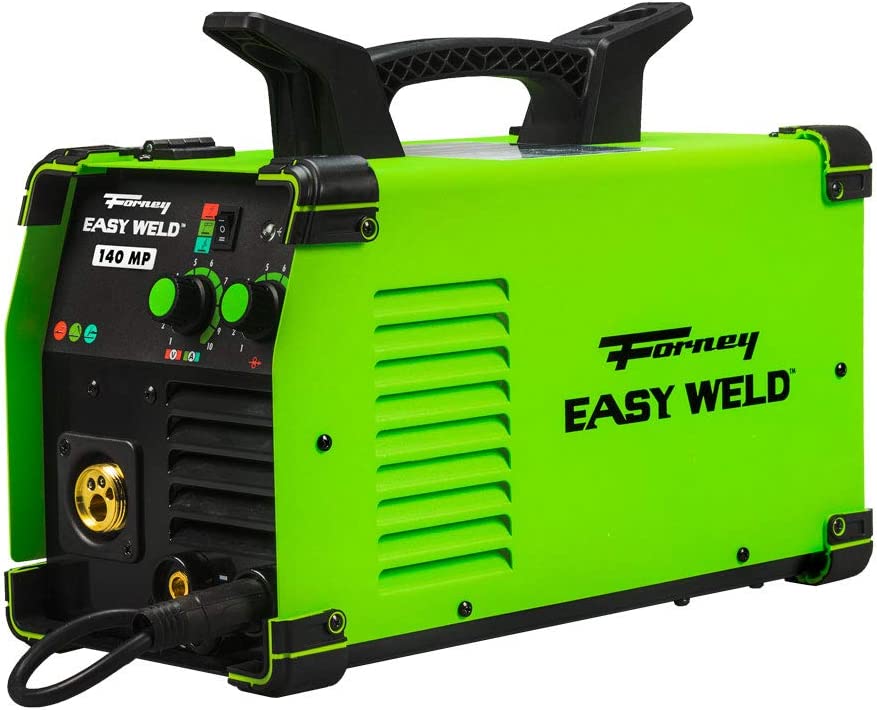
A portable 140-amp MIG welder made for mild steel, aluminum, and stainless steel is the Forney Easy Weld 271, 140 MP. On thin metal parts up to 1/4 inch thick, it applies high-quality MIG welds. It can stick and TIG weld in addition to being a MIG welder.
It has a built-in gas solenoid valve, dual voltage inputs (120V/240V), and a fan-cooled wire drive system. The machine comes with a 6 foot ground cable and clamp, a 10 foot MIG gun and cable assembly, a regulator and hose, and a 0.030″ flux cored solder sample spool.
You can instantly switch the process using the three-position switch. You may achieve the ideal weld by adjusting the wire feed speed and voltage to an infinite range. Range of the rated output voltage: 12 to 23V. The output current range is 43 to 110A. 10 to 140A is the full output current range.
Due to the machine’s integrated flux core coil, welding without shielding gas is possible. It offers versatility for various welding operations with its four power settings and limitless wire speed control. The device is appropriate for both home and business use and is portable, lightweight, and simple to operate.
3. Lincoln Electric K2185-1 Handy
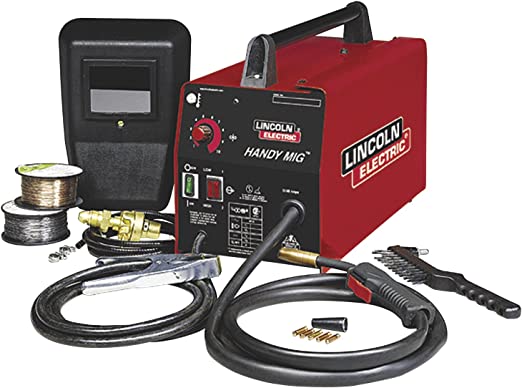
One such welding device that is both adaptable and well-made is the Lincoln Electric K2185. The lead on this welder is 8 inches long, which is longer than the lead on the majority of cheap machines despite the fact that the welder itself is bigger and heavier than other, more potent welders.
The Lincoln Electric K2185-1 Handy MIG Welder is a portable and versatile MIG welder that is suitable for welding aluminum, steel, and stainless steel. It has a maximum output of 140 amps and is capable of welding materials up to 1/8 inch thick. The welder has a compact and lightweight design, making it easy to carry and store, and it is user-friendly with a simple control panel.
As one of the best MIG welders, this one is also great for inert gas welding for novices. It offers superior arc control thanks to diamond core technology. Really simple and easy to use controls are provided.
Additionally, for extended usage, it boasts a fan-cooled architecture and power levels that can be adjusted. It costs less than $500 to purchase this welder. Beginners, enthusiasts, and those interested in do-it-yourself projects will find it to be reasonably priced, of excellent quality.
4. Eastwood 140 Amp ($399.99)
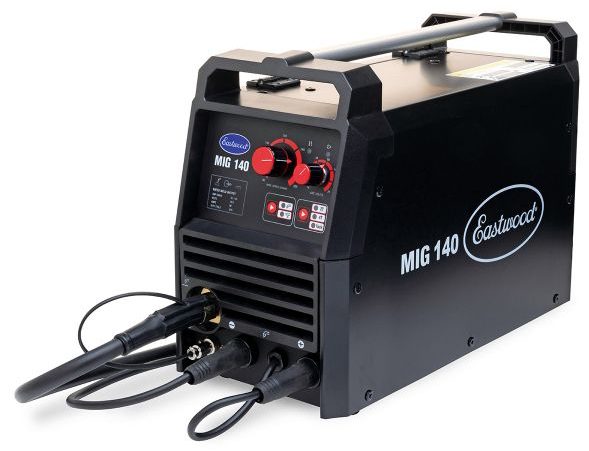
A modernized version of the beloved old Eastwood MIG 135 by many welders, the MIG 140. The unique IGBT inverter technology used by the new welding equipment makes it stronger, more effective, and lighter. You can simply move it around the store because it weighs 24.1 lbs.
This Eastwood MIG welder is rated at 140 amps, like the majority of MIG welders priced around $500. As a result, gauges 24 to 3/16′′ of mild steel and stainless steel can be used with it. For small applications, a 30% duty cycle at 90 amps is adequate. The Eastwood MIG 140 can weld aluminum because it is a gun-compatible equipment.
Due to the welder’s numerous customizable settings, it is simple to adapt the welding procedure to suit various materials and thicknesses. For DIYers and hobbyists looking for a trustworthy and reasonably priced MIG welder for their welding projects, it is fantastic.
5. Hobart 500572 Handler 100 ($299.99)
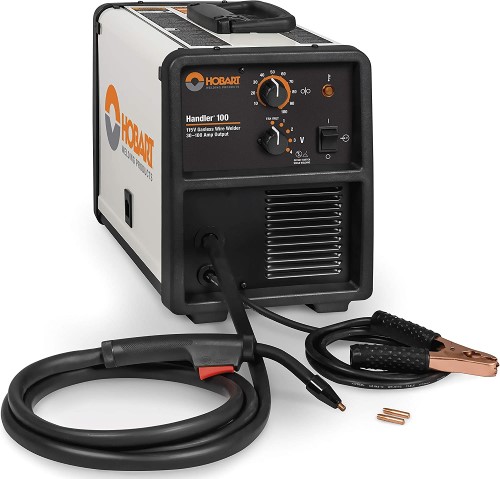
The Hobart 500572 Handler 100 is a versatile MIG welder suitable for welding aluminum and other metals. You can use flux cored wire and the Hobart 500572 Handler 100 to weld steel up to 3/16 inch (4.8 mm) thick. It provides each wire with a large operating window and quick and simple adjustment for various thicknesses and splices.
Additionally, it allows you the choice of using tiny or large coils, depending on what is best for your welding needs. Both 4-inch and 8-inch spools can fit the wire drive. Forward feed with tension that is easily adjustable and accessible for new wire.
The power cable stays “cool” until the trigger is pulled thanks to its simplicity of use and strong safety features. The range of this little machine is 30 to 100 amps. You can fix things like gate hinges with the 3/16 inch maximum, and you can work with auto body metal like doors, floor panels, and more with the 24 gauge sheet metal capability.
The welder has a five-position voltage control selector that makes it simple to fine-tune the arc and get the desired results on a variety of materials. The welder is a popular option for people who require a portable MIG welder to weld aluminum because of how easy it is to move and its compact form. The transformer of the Hobart 500572 Handler 100 is covered by a 5-year warranty from Hobart.
What features should I look for in a best MIG welder for aluminum?
Aluminum compatibility
Aluminum compatibility refers to a MIG welder’s ability to effectively weld aluminum and aluminum alloys. When shopping for a MIG welder, it’s important to make sure that the welder you choose is specifically designed for aluminum welding, as not all MIG welders are suitable for this application.
A welder designed for aluminum welding will typically have the capability to handle aluminum welding wire of a smaller diameter, such as 0.35mm or 0.45mm, and may have special features such as a spool gun or push-pull gun for easy feeding of aluminum welding wire.
High Amperage
High amperage refers to the maximum welding current output of a MIG welder. When welding aluminum, a higher amperage range is typically required to effectively heat and melt the aluminum. A welder with a higher amperage range, typically over 200 amps, is recommended for aluminum welding.
This will allow you to successfully weld thicker pieces of aluminum, as well as provide more control over the welding process. A higher amperage also means a stronger weld, which can be important for critical applications. However, it’s also important to ensure that the welder has a good voltage control system to avoid overheating the aluminum.
Spool gun compatibility
A spool gun is a device that attaches to the MIG welder and allows for easier and more precise welding of aluminum wire. Spool guns have a smaller, dedicated spool of wire inside the gun, which reduces the risk of feeding problems. If you plan on welding aluminum often, or if you need to weld thin sheets of aluminum, a spool gun is highly recommended.
Wire Feeding
Adjustable wire feed speed allows you to control the speed at which the filler metal is fed into the welding puddle. This is an important feature for welding aluminum because it enables you to fine-tune the welder to suit the specific thickness and type of aluminum you’re working with, which helps to produce a consistent, high-quality weld.
Having control over the wire feed speed can also help you avoid problems such as burn-through and undercutting, which can occur when the wire feed speed is too high or too low.
High-Frequency Start
High frequency start refers to a feature that helps start the arc of the welding process consistently and easily. It works by generating a high frequency spark to ignite the arc, which then melts the aluminum and creates a continuous weld.
This is especially important when welding aluminum, as the aluminum oxide that forms on the surface can prevent a stable arc from being struck. A welder with high-frequency start capability will ensure consistent and successful arc starts, making the welding process smoother and more efficient.
Adjustable Settings
Adjustable settings refer to the ability of a MIG welder to be configured to various parameters to achieve optimal results. This includes the ability to adjust the amperage, wire feed speed, and gas flow.
These settings are important when welding aluminum, as they allow you to fine-tune the welding process to match the specific thickness and composition of the aluminum being welded.
An MIG welder with adjustable settings gives you more control over the welding process, resulting in better weld quality, consistency, and efficiency. Some welders may also have pre-programmed settings for different materials, which can make the process even easier.
Pulse welding
Pulse welding is a type of MIG welding that involves pulsing the current to the filler wire. In a pulse welding cycle, the welder alternates between high and low current levels, which helps to control the heat input into the metal and reduce the risk of warping or overheating the metal.
Pulse welding is commonly used for aluminum welding because it produces a more stable arc and helps to minimize heat buildup in the metal. This results in a cooler and more controlled welding process, which helps to reduce the risk of warping or burning through the metal.
Pulse welding also provides greater control over the welding process, allowing for more precise welding and a better-looking finished product.
Power Supply
The power supply of a MIG welder refers to the type of power source it uses. MIG welders can be powered by either AC (alternating current) or DC (direct current) power sources. For aluminum welding, a DC power source is generally recommended, as it provides a more stable and consistent arc, making it easier to produce high-quality welds.
A welder with a high-quality DC power source will also typically have a wider amperage range, which can be important when welding thicker pieces of aluminum. Additionally, a welder with a built-in voltage control system will allow you to fine-tune the welding process to achieve the best results.
Frequently asked questions (Weld FAQ)
What is the best MIG welder for Aluminum?
A MIG welder with a spool gun is typically the best MIG welder for aluminum as it allows for more precise control and smoother welding of the thinner aluminum material.
Can a MIG welder be used for both steel and aluminum?
Yes, many MIG welders are designed to be used for welding both steel and aluminum. However, the specific settings, wire type, and gun attachments may need to be adjusted for each type of material.
Can a MIG welder be used for welding aluminum outdoors?
Yes, MIG welding can be done outdoors, but it is important to take necessary precautions such as providing adequate ventilation, protecting the welder from the elements, and ensuring a stable and dry power source.
How important is wire feed speed control for aluminum welding?
Wire feed speed control is important for aluminum welding as it affects the heat input and overall quality of the weld. A MIG welder with adjustable wire feed speed control can help optimize the welding process for aluminum.
What is the difference between a MIG welder for steel and a MIG welder for aluminum?
MIG welders for aluminum typically have a higher amperage range and can handle smaller diameter welding wire. They may also have features such as a spool gun for easier wire feeding and high-frequency start for consistent arc ignition.
Rounding It Up
Want to weld aluminum beautifully, in addition to the aluminum welding technique learned, it also needs to depend on skillful workmanship. To do so, you need to work hard to practice aluminum welding every day to become more proficient in different aluminum welding positions for each specific weld.
Are you looking for the best MIG welder for Aluminum? Above are our recommendations which we think are best for you. Want to get started with easier-to-use welders at affordable prices? We also have an article about this. Come to WeldFAQ and send me some welding frequently questions, you will know more about welding!

